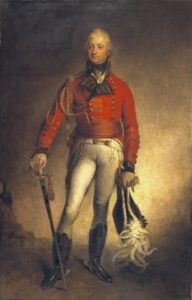For the past several years, museums and other cultural institutions have been reevaluating their collections to curate exhibitions through a number of different lenses. Looking at a piece or several pieces within the context of colonialism or imperialism can drastically change how a work of art is interpreted. Across the world, museums and museum visitors are starting to curate their exhibitions in this way more frequently. I’ve previously written about a controversial statue in Bristol and a royal carriage in the Netherlands. But now, another controversial artwork will be given this treatment, this time at a museum in Wales.
Sir Martin Archer Shee created his portrait of Lieutenant General Sir Thomas Picton around 1812 and was first shown at the Royal Academy in 1816, a year after the subject’s death. The picture was donated to the National Museum in Cardiff in 1907 by the Earl of Plymouth, Robert Windsor-Clive. Originally from a small village in Pembrokeshire in southwestern Wales, Picton was the highest-ranking British officer killed at the Battle of Waterloo. He was previously lionized as a Welsh national hero, but nowadays, Picton is often remembered differently. In 2020, a statue of Picton was removed from Cardiff City Hall’s Heroes of Wales gallery, while just earlier this year, Shee’s portrait of Picton was removed from the National Museum’s Faces of Wales gallery. Picton’s reputation is souring because of increased discourse and debate surrounding his time as the British governor of Trinidad between 1797 and 1803. There, he became known for his cruelty towards people of color, both enslaved and free. Accounts are plentiful of him leading or ordering the arbitrary torture and murder of people across the island, hanging, mutilating, or sometimes burning them alive. He also started dealing in human cargo, which is how he built his fortune. In 1803, authorities hauled him back to London to stand trial for the torture of a 14-year-old free mixed-race girl named Luisa Calderón. He was convicted of this crime. So even by his contemporaries, he was considered a horrible individual. The Duke of Wellington later called him “a rough foul-mouthed devil”.
After being removed from the Faces of Wales gallery, the portrait was placed in a side room in a large packing box. The point of the box, according to the National Museum’s director of collections Dr. Kath Davies, is to express a lack of permanence. For now, the portrait is part of an exhibition called Reframing Picton, which also features works by Trinidadian and Trinidadian-British artists and arts groups like Gesiye and Laku Neg. Trinidad and Tobago only gained its independence from Britain in 1962 and did not have its own elected president until 1976 (Queen Elizabeth II was still head of state for the time being). Therefore, British influence on daily life is still a potent force. Ironically, Gesiye told WalesOnline that her mother grew up in Port-of-Spain on Picton Street. The museum has been carefully working alongside groups like the Sub Sahara Advisory Panel (SSAP), an organization representing the African diasporic population in Wales, to tell all aspects of Picton’s influence. Fadhili Maghiya, the SSAP’s director, stated, “There might be misconceptions that we are seeking to rewrite history with this project. However, that is far from the truth. Reframing Picton aims to rewrite our future by challenging the way we engage with history.” Alongside the contemporary art, the exhibition also features documents from Picton’s trial, as well as artifacts from the eighteenth-century British anti-slavery movement.
It’s important and good to show how many figures held up in reverence often occupied the gray areas of our moral compass. In the US, many are having similar conversations about people like Thomas Jefferson. At the end of the day, we have to realize that no one is wholly good or wholly bad, but a work of art can mostly show just a single snapshot of a person. So to tell the whole story, exhibitions like Reframing Picton have to be put on to give the viewer the context necessary to make an informed decision on how they view something.

